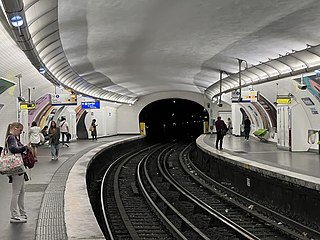
Ternes is a station on Line 2 of the Paris Métro, under the Place des Ternes on the border between the 8th and 17th arrondissements.

Courcelles is a station on Paris Métro Line 2, under the Boulevard de Courcelles on the border of the 8th and 17th arrondissement of Paris.

Jaurès is a station on Paris Métro line 2, line 5, and line 7bis in the 10th and 19th arrondissements.

Belleville is a station on Paris Métro Line 2 and Line 11. The station is in the district of Belleville at the corner of the 10th, 11th, 19th and 20th arrondissements.

Philippe Auguste is a station on Line 2 of the Paris Métro, on the border of the 11th and 20th arrondissements.

Alexandre Dumas is a station on Line 2 of the Paris Métro, on the border of the 11th and 20th arrondissements.

Avron is a station on Line 2 of the Paris Métro, on the border of the 11th and 20th arrondissements.

Porte de Champerret is a station on Paris Métro Line 3.

République is a station on Lines 3, 5, 8, 9 and 11 of the Paris Métro. It is located under the Place de la République, at the tripoint border of the 3rd, 10th and 11th arrondissements. It is an important interchange station; its 16.6 million users (2019) make it the seventh busiest out of 302 on the Métro network.

Place d'Italie is a rapid transit station of the Paris Métro located in the heart of the 13th arrondissement of Paris, at the Place d'Italie. It is the southern terminus of Line 5 and is also served by Line 6 and Line 7.

Cambronne is an elevated station on line 6 of the Paris Métro. Located in the 15th arrondissement. It is named after the nearby Place Cambronne and rue Cambronne, which was in turn named after Viscount Pierre Cambronne (1770–1842), a general at the Battle of Waterloo. The station is at the location of the Barrière de l'École-Militaire, a gate built for the collection of taxes as part of the Wall of the Farmers-General; the gate was built between 1784 and 1788 and was demolished before 1859.

Glacière is an elevated station of the Paris Métro serving line 6 in the 13th arrondissement.

Corvisart is an elevated station of the Paris Métro serving line 6 at the intersection of the Rue du Corvisart and the Boulevard Auguste Blanqui in the 13th arrondissement.

Chevaleret is an elevated station of the Paris Métro serving line 6 at the intersection of the Rue du Chevaleret and the Boulevard Vincent Auriol in the 13th arrondissement.

Quai de la Gare is a station on Line 6 of the Paris Métro. It is located at the intersection of the Quai de la Gare and Boulevard Vincent Auriol, in the 13th arrondissement.

Dugommier is a station of the Paris Métro on Line 6 in the 12th arrondissement.

Daumesnil is a station on Line 6 and Line 8 of the Paris Métro in the 12th arrondissement.

Tolbiac is a station of the Paris Métro. It is at the crossroads of two main roads, the Avenue d'Italie and the Rue de Tolbiac. It is near the Asian Quarter and the Parc de Choisy.

Porte de Saint-Ouen is a station on line 13 of the Paris Métro on the border of the 17th and 18th arrondissements. Unusually it has an escalator directly linking the platform to the street at the exit to the Rue Leibniz.

Sèvres–Lecourbe is an elevated station of the Paris Métro serving line 6 at the intersection of several streets including the Rue de Sèvres and the Rue Lecourbe in the 15th arrondissement.





















